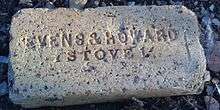Evens & Howard Fire Brick Co.



The Evens & Howard Fire Brick Company was a manufacturer of fire bricks, sewage pipe and gas retorts in what is now the Cheltenham neighborhood of St. Louis, Missouri. It was founded formally in 1855 as the Cheltenham Fireclay Works and achieved sales as far away as Quebec[1] and Africa. One source dates the beginning of the company back to 1837, but under different owners.[1] In 1855, the works were owned by Charles Chouteau.[1] The firm was incorporated in 1867 when Evens & Howard took possession of it.[1] At the time of its operation, it was one of the oldest manufacturers of fire bricks in St. Louis.[2][3] At one point, its grounds covered 133 acres (54 ha).[3] According to one report, the mining was done below ground by "pick and blast". In 1904, clay extraction took place at three mines: two in St. Louis and one in Glencoe, Missouri. The company had an extensive equipment network of cars and tracks to bring clay to the plant. Evens & Howard's offices were located on Market Street in St. Louis.[3]
An 1875 fire consumed the brickworks,[1] causing $50,000 in damage[4] ($1.08 million adjusted for inflation).[5] Parts of the sewer pipe division were destroyed by fire at least twice. In 1949, a fire that started in the factory locker room consumed two four-story factory buildings. The fire was visible as far as 25 miles (40 km) from St. Louis, attracted some 10,000 spectators, and caused an estimated $325,000 in damage[6] ($3.24 million adjusted for inflation).[5] One of the two buildings burned again in 1958, causing over $125,000 in damage[7][8] ($1.03 million adjusted for inflation).[5]
The company was acquired by General Refractories in 1930, which continued to operate the Evens & Howard plant under its old name.[9]
Richmond Heights
Evens & Howard were instrumental in the establishment of the African American neighborhoods in Richmond Heights, Missouri in the early 20th century. Racial segregation at the time restricted African Americans to specific portions of St. Louis County, and Evens & Howard needed workers for the nearby brickworks. They were able to convince officials to develop the neighborhoods, and many families moved in once the company built employee housing.[10] Hadley Township, which contains Richmond Heights, was founded in 1907.[11]
References
- 1 2 3 4 5 Compton, Richard J., ed. (1876). "Evens and Howard Brick Company Fire". Pictorial St. Louis: The Great Metropolis of the Mississippi Valley. Illustrated by Camille N. Dry. St. Louis: Compton & Co. p. 51. OCLC 52414172.
- ↑ Harvard, Francis Thompson (1912). Refractories and furnaces. New York City: McGraw-Hill. p. 12.
- 1 2 3 "The Clayworking Plants of St. Louis". Brick. Chicago: Kenfield. 20 (5): 232–233. May 1904. ISSN 0096-4468.
- ↑ "Fire Record". Boston Post. 12 January 1875. p. 3 – via Newspapers.com.

- 1 2 3 Federal Reserve Bank of Minneapolis Community Development Project. "Consumer Price Index (estimate) 1800–". Federal Reserve Bank of Minneapolis. Retrieved October 21, 2016.
- ↑ "Charred Remains of Building Probed". Edwardsville Intelligencer. UP. 21 September 1949. p. 2. Retrieved 14 August 2014 – via Newspapers.com.

- ↑ "St. Louis Blaze Destroys Factory". Iola Register. AP. 16 September 1958. p. 6. Retrieved 14 August 2014 – via Newspapers.com.

- ↑ "Fire Destroys Plant of Evans & Howard". Bridgeport Telegram. Dow Jones. 17 September 1958. p. 33. Retrieved 14 August 2014 – via Newspapers.com.

- ↑ "General Refractories: Has Acquired Properties of Evens & Howard Fire Brick Co. of St. Louis". Wall Street Journal. January 15, 1930. p. 11.
- ↑ McDonald, Joellen Gamp; Ruth Nichols Keenoy (August 14, 2006). Richmond Heights: 1868-1940. Charleston, South Carolina: Arcadia Publishing. pp. 9, 17, 101 and 110. ISBN 0-7385-3992-9.
- ↑ Gillerman, Margaret (March 8, 2014). "Richmond Heights' Hadley Township South neighborhood has become history". St. Louis Post-Dispatch.
External links
- Bob Corbett's page on Evens & Howard
- Historical sketch from Compton's
- Magazine article circa 1904